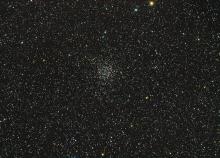Listen to today's episode of StarDate on the web the same day it airs in high-quality streaming audio without any extra ads or announcements. Choose a $8 one-month pass, or listen every day for a year for just $30.
You are here
Cassiopeia
Characters in Greek mythology never seemed to learn that it was a bad idea to disrespect the gods. Consider Cassiopeia, the queen of Ethiopia. Her vanity led to all kinds of trouble with the gods — and eventually got her placed in the stars.
Cassiopeia was a great beauty. But her trouble started when she boasted that she was more beautiful than a group of sea goddesses known as the Nereids. They didn’t like the put-down at all, and they plotted revenge.
One of them was married to the sea god, Poseidon. As a punishment, he sent the monster Cetus to ravage the coast of Ethiopia. To appease him, Cassiopeia and her husband, King Cepheus, chained their young daughter Andromeda at the shore as a sacrifice.
Before Cetus could get her, though, she was rescued by Perseus, who killed the monster. Perseus and Andromeda were married and, according to most versions of the tale, lived a long and happy life together.
Cassiopeia’s punishment wasn’t over, though. In fact, it’s still going on. The gods placed her in the stars, where she wheels around the North Star. Part of the time she sits upright, but part of the time she hangs upside down — one last indignity for disrespecting the gods.
Look for Cassiopeia well up in the northeast at nightfall. She’s easy to find because her brightest stars form a letter M or W. The constellation wheels high across the north after midnight.
Tomorrow: remnants of a disappearing comet.
Script by Damond Benningfield





